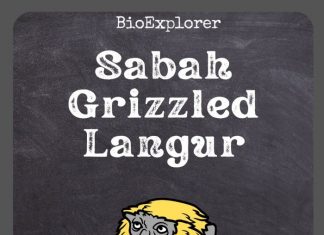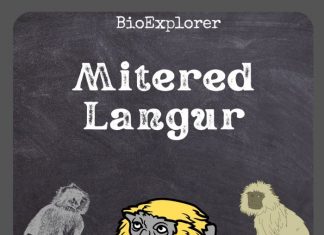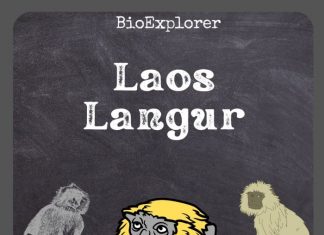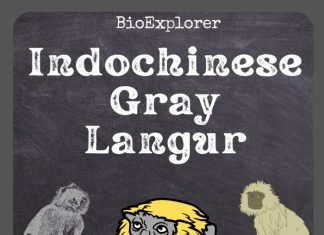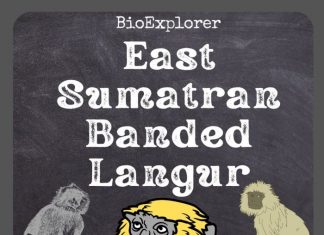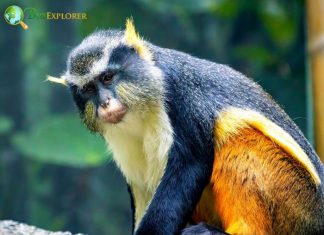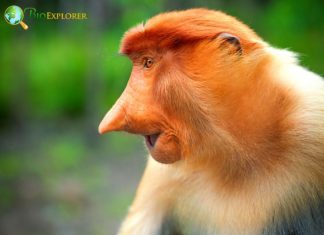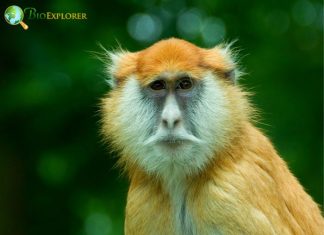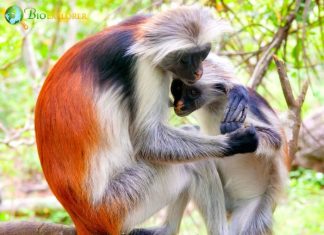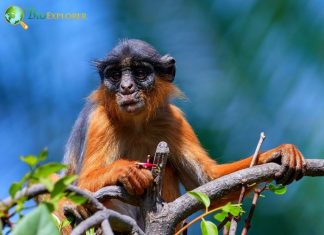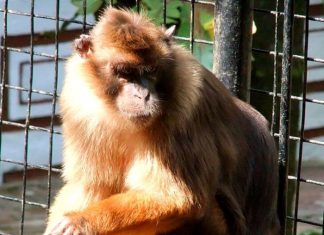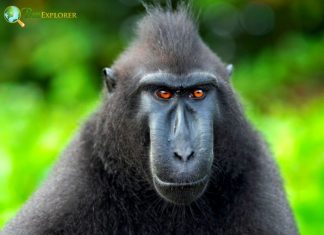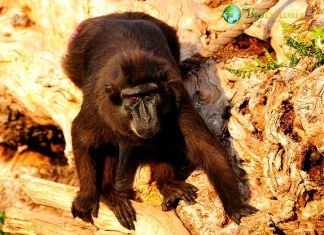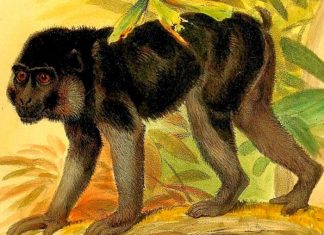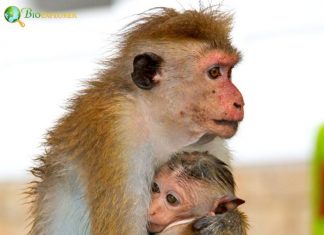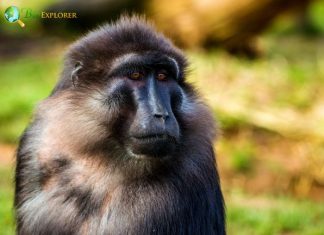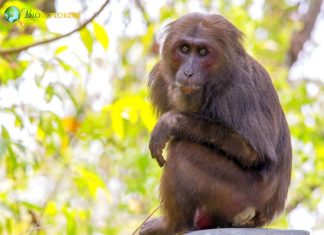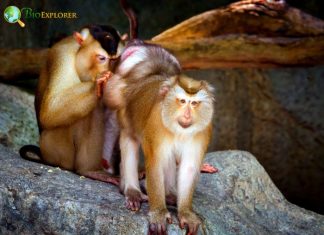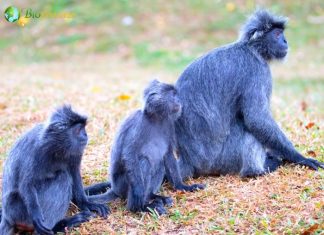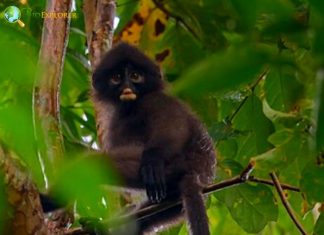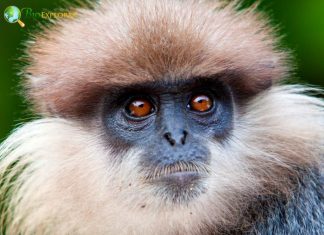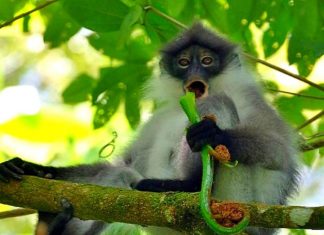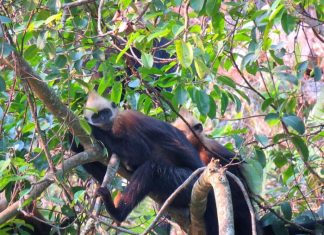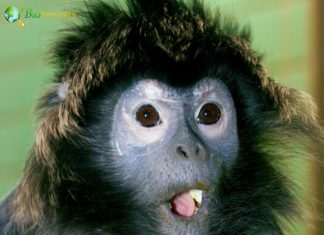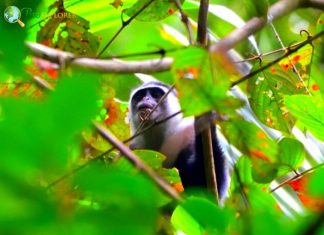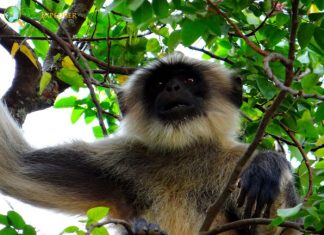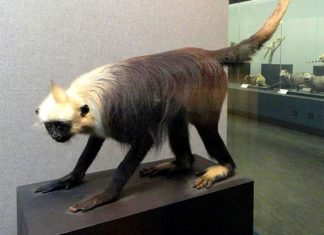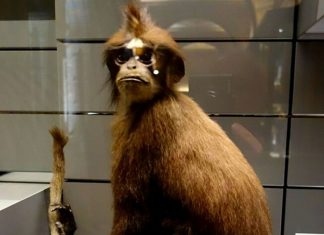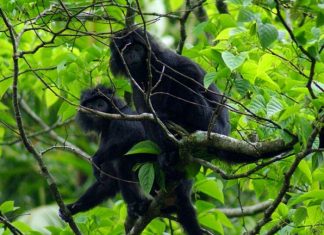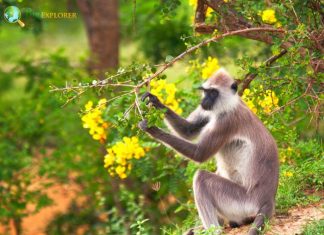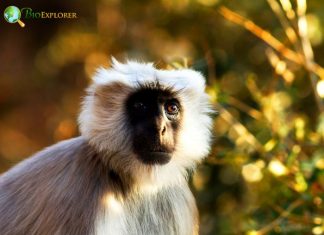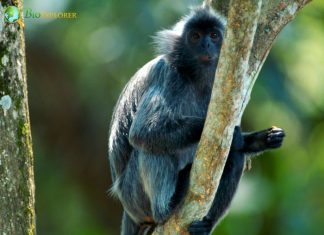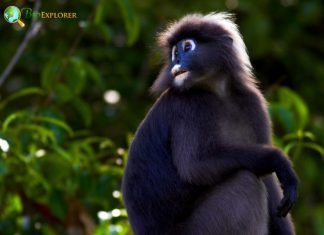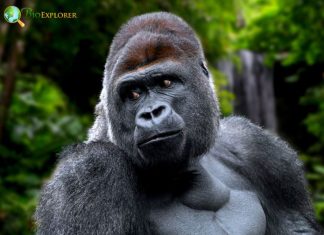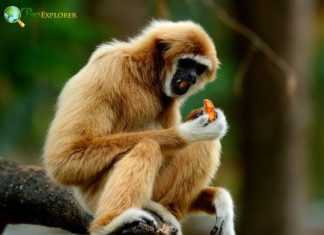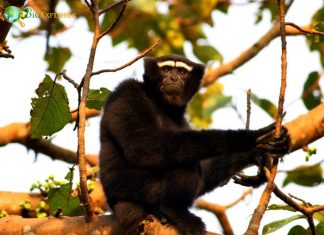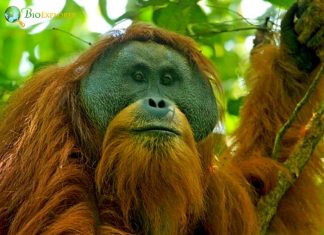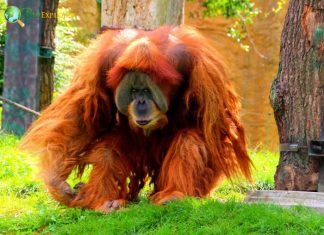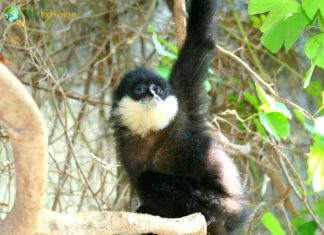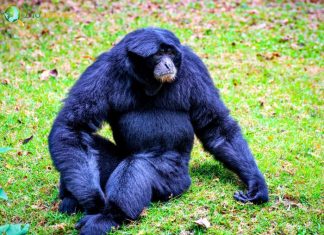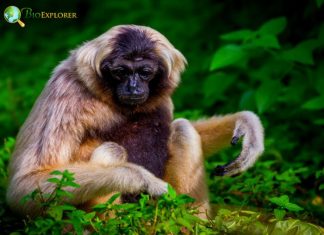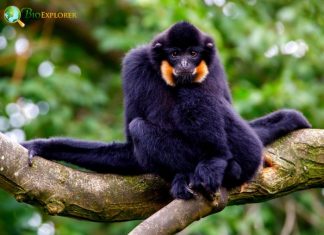Bouvier’s Red Colobus
Species Name: Piliocolobus bouvieri
Bouvier's Red Colobus was rediscovered in 2015 in the Republic of Congo after four decades without confirmed sightings. These African primates live in the swampy forests surrounding the Congo River, between the mouths of the Oubangui and Alima rivers.
Saban Grizzled Langur
Species Name: Presbytis sabana
Saban Grizzled Langur was once thought to be a subspecies of the Hose's langur, Presbytis hosei (as Presbytis hosei sabana). The Saban grizzled langur is endemic to the island of Borneo in the Malaysian province of Sabah, with part of its range in Indonesia.
Pig-tailed Langur
Species Name: Simias concolor
The pig-tailed langur (Simias concolor), monotypic in the Simias genus, is a great Old-World monkey native to several small islands off Sumatra, Indonesia. Adult pig-tailed langurs have black faces and small, turned-up noses.
Mitered Langur
Species Name: Presbytis mitrata
The mitered langur has brown or gray fur on its back, darker, while it is even darker on its belly and the arms, legs, and tail. These Indonesian primates live in groups of 1 male with 5 to 17 females.
Miller’s Langur
Species Name: Presbytis canicrus
Miller's Langur (Presbytis canicrus), also called the Kutai Gray Langur, is the rarest of the four Hosei subspecies, all of which are native to the island of Borneo. One of the world's most endangered primates, Miller's langur, was once considered extinct until it was rediscovered in 2013.
Mentawai Langur
Species Name: Presbytis potenziani
Mentawai Langur is also called the Long-Tailed Langur, and it is native to the Mentawai Islands in Indonesia. The pelage of Mentawai langur is medium length, longer on the back of the shoulders and anterior of the flanks and shorter on the face, neck, abdomen, and under the thighs.
Laotian Langur
Species Name: Trachypithecus laotum
The Laotian langur (Trachypithecus laotum), also known as white-browed black langur, is another primate species that nest in small limestone caves and holes that shelter from predators, rain, and cold.
Indochinese Grey Langur
Species Name: Trachypithecus crepusculus
The Indochinese gray langur (Trachypithecus crepusculus) is a species of Lutung native to Southeast and East Asia. This species was once thought to be conspecific with the Phayre's leaf monkey (Trachypithecus phayrei).
Hatinh Langur
Species Name: Trachypithecus hatinhensis
The Hatinh langur (Trachypithecus hatinhensis) is a critically endangered Old World monkey found in the limestone forests of Vietnam, particularly in Quảng Bình province. Contrary to their common name, the Hatinh langur is not known from the province of Hà Tĩnh.
Germain’s Langur
Species Name: Trachypithecus germaini
Germain's Langur is a lutung species endemic to Thailand, Vietnam, Laos, Cambodia, and Burma. Germain's langur is a terrestrial tree-dwelling species occasionally found in lowlands.
East Sumatran Banded Langur
Species Name: Presbytis percura
The East Sumatran banded langur also called the East Sumatran banded surili are primarily found in the fragmented landscape of pulp and rubber plantations. These surilis are shy and alert creatures, rarely leaving the comfort of their canopies.
Delacour’s Langur
Species Name: Trachypithecus delacouri
The Delacour's langur, also known as Delacour's Lutung, is an endangered Lutung native to northern Vietnam. The species is named after Jean Théodore Delacour, a French-American ornithologist.
Cross Marked Langur
Species Name: Presbytis chrysomelas
The Sarawak surili, also known as Cross-marked Langur, is a monkey species in the Cercopithecidae family. The Sarawak surili was once considered widespread but has declined significantly due to habitat and loss persecution.
Wolf’s Mona Monkey
Species Name: Cercopithecus wolfi
The Wolf's mona monkey (Cercopithecus wolfi), also called the wolf monkey, is a colorful Old-World monkey in the Cercopithecidae family. Wolf's mona monkeys have huge cheek pouches.
Proboscis Monkey
Species Name: Nasalis larvatus
The proboscis monkey (Nasalis larvatus) is an Old World arboreal species with an unusually large nose, reddish-brown skin color, and a long tail. The proboscis monkey is a large species and one of the largest old-world monkey species native to Asia.
Patas Monkey
Species Name: Erythrocebus patas
The Patas Monkey (Erythrocebus patas), also called the Hussar Monkey or Wadi Monkey is a terrestrial monkey distributed in semi-arid areas of West and East Africa. The patas monkey lives in multi-female groups of about 60 individuals (although much larger aggregations have been reported).
Zanzibar Red Colobus
Species Name: Piliocolobus kirkii
The Zanzibar red colobus (Piliocolobus kirkii) is endemic to Unguja, the main island of the Zanzibar archipelago off the coast of Tanzania. The Zanzibar red colobus, often referred to as Kirk's red colobus is named after Sir John Kirk, the British resident of Zanzibar who first spotted these creatures.
Western Red Colobus
Species Name: Piliocolobus badius
The western red colobus (Piliocolobus badius), also called the Upper Guinean red colobus, rust red colobus, or bay red colobus is a species of Old-World monkey found in the forests of West Africa, from Senegal to Ghana.
Pagai Island Macaque
Species Name: Macaca pagensis
The Pagai island macaque (Macaca pagensis), also called the Pagai or Bokkoi macaque is an Old-World monkey native to the Mentawai Islands on the west coast of Sumatra. Groups of Pagai Island macaques consist of approximately 5 to 25 individuals.
Heck’s Macaque
Species Name: Macaca hecki
The Heck's Macaque (Macaca hecki) is a macaque native to Sulawesi, Indonesia. This Old-World monkey is diurnal. Due to their frugivorous diet, Heck's macaques will likely act as seed dispersers throughout their habitat.
Gorontalo Macaque
Species Name: Macaca nigrescens
The Gorontalo macaque (Macaca nigrescens), also called the Dumoga-bone macaque, is a species of the primate of the Cercopithecidae family. It is native to the Sulawesi Island of Indonesia.
Booted Macaque
Species Name: Macaca ochreata
The booted macaque is a macaque native to Indonesia's Sulawesi Island. This Old-World monkey is diurnal, spending most of the day in trees. A booted macaque monkey's body mass is determined by its sex, with males significantly larger than females.
Toque Macaque
Species Name: Macaca sinica
The toque macaque (Macaca sinica) is a red-brown Old World monkey endemic to Sri Lanka, known as the rilewa or rilawa. Its common name refers to the strand of hair on its head that resembles a brimless hat.
Tonkean Macaque
Species Name: Macaca tonkeana
Tonkean macaques also known as Tonkean black macaques, are endemic to the central part of the island of Sulawesi and the neighboring Togian Islands in Indonesia. Tonkea macaques are pretty intelligent and creative.
Stump-tailed Macaque
Species Name: Macaca arctoides
The stump-tailed macaque, also known as the bear macaque, is an Old World monkey endemic to Cambodia, northeastern India, southwestern China, Myanmar, and Laos, from northwestern Peninsular Malaysia, Vietnam, and Thailand.
Sunda Pig-Tailed Macaque
Species Name: Macaca nemestrina
The pig-tailed macaque (Macaca nemestrina), also called the Sundaland pig-tailed macaque and Sunda pig-tailed macaque is a medium-sized macaque native to southern Thailand, Indonesia, and Malaysia. Pig-tailed macaques also have long legs and hairless snouts.
Selangor Silvered Langur
Species Name: Trachypithecus selangorensis
The Selangor silvered langur (Trachypithecus selangorensis) is a leaf monkey living on the west coast of the Malay Peninsula. Like most leaf monkeys, the Selangor silvered langur usually lives in groups of a single adult male and several adult females and their young offspring.
Robinson’s Banded Langur
Species Name: Presbytis robinsoni
Robinson's banded langur (Presbytis robinsoni), also known as Robinson's banded surili, is a monkey species in the Cercopithecidae family. Robinson Banded Langurs are generally shy and alert creatures, rarely leaving the comfort of the canopy.
Purple-faced Langur
Species Name: Semnopithecus vetulus
The purple-faced langur (Semnopithecus vetulus), also called the purple-faced leaf monkey, is an Old World species native to Sri Lanka. The purple-faced langur is found in the closed forests of Sri Lanka's mountains and in the southwestern part of the country known as the 'wetland'.
Pale-Thighed Langur
Species Name: Presbytis siamensis
The pale-thighed surili (Presbytis siamensis), also called the white-thighed langur, is a primate species in the Old World monkey family (Cercopithecidae). Pale-thighed langurs are savvy herbivores; it's fun to say they only eat plants and have a fussy palate, with a preference for young leaves, seeds, and fruits.
Cat Ba Langur
Species Name: Trachypithecus poliocephalus
The white-headed langur, also called the Cat Ba langur, is an endangered species of langur native to Guangxi, China. Cat Ba langurs are comfortable in trees or ground but prefer steep cliffs where humans can't set foot.
Tenasserim Langur
Species Name: Trachypithecus barbei
Tenasserim lutung (Trachypithecus barbei) is a species of lutung. It occurs in Thailand and Myanmar. The species derived its common name from the Tenasserim Hills.
Siberut Langur
Species Name: Presbytis siberu
Siberut langurs are native to the islands of North Pagai, South Pagai, and Sipora. Siberut langurs spend over 80 percent of their time resting and foraging and only a tiny portion traveling and socializing.
Shortridge’s Capped Langur
Species Name: Trachypithecus shortridgei
The Shortridge's capped langur (Trachypithecus shortridgei) is a colobine primate inhabiting low to medium evergreen and semi-evergreen forests east of the Chindwin River in northeastern Myanmar and southwestern Myanmar, China, in the Nu and Dulong valleys.
White-headed Langur
Species Name: Trachypithecus leucocephalus
The white-headed langur (Trachypithecus leucocephalus) is an endangered species of langur native to Guangxi, China. As the common name suggests, a tuft of white fur covers this primate's head.
White-fronted Langur
Species Name: Presbytis frontata
The white-fronted surili (Presbytis frontata) is a primate species in the Cercopithecidae family, the Old World monkeys. This species prefers to eat immature leaves than more mature leaves.
West Javan Langur
Species Name: Trachypithecus mauritius
The West Javan langur (Trachypithecus mauritius) is an Old-World monkey of the Colobinae subfamily. It was previously considered a subspecies of Trachypithecus auratus until Roos and Groves raised it to its own species.
Tufted Gray Langur
Species Name: Semnopithecus priam
The tufted gray langur (Semnopithecus priam), also called the Coromandel sacred langur and the Madras gray langur, is an Old-World monkey, one of the langur species. These langurs are generally shy and only descend when there is no visible danger.
Tarai Gray Langur
Species Name: Semnopithecus hector
The Tarai gray langur (Semnopithecus hector) is an Old-World monkey and was once thought to be a subspecies of the northern plains gray langur. The Latin name for Tarai gray langurs is inspired by Hector, the prince of Troy.
Silvered Langur
Species Name: Trachypithecus cristatus
The silvery Lutung (Trachypithecus cristatus), also called the silvery langur or silvered leaf monkey is an Old-World monkey. Silvery Lutungs primarily live in trees.
Phayre’s Langur
Species Name: Trachypithecus phayrei
Phayre's leaf monkey (Trachypithecus phayrei), also called the Phayre's langur, is a species of Lutung endemic to South and Southeast Asia. The name commemorates the late Sir Arthur Purves Phayre, a lieutenant general in the British Indian Army and commissioner of the entire province of former British Burma.
Western Gorilla
Species Name: Gorilla gorilla
Western gorillas also known as lowland gorillas, are herbivorous, primarily terrestrial apes that inhabit equatorial Africa's tropical rainforests. Like humans, western gorillas do not have a set breeding season, and female species menstruate every 28 days.
Lar Gibbon
Species Name: Hylobates lar
The lar gibbon (Hylobates lar), also called the white-handed gibbon, is another endangered mammal in the gibbon family, Hylobatidae. It is among the best-known gibbons and is occasionally kept in captivity. Lar gibbons have a two-tone coat.
Western Hoolock Gibbon
Species Name: Hoolock hoolock
are three species of primates in the Hoolock genus of the gibbon family, Hylobatidae, endemic to Myanmar, eastern Bangladesh, northeastern India, and southwestern China.
Tapanuli Orangutan
Species Name: Pongo tapanuliensis
The Tapanuli orangutan (Pongo tapanuliensis) is an orangutan species restricted to the southern Tapanuli on the island of Sumatra in Indonesia. It was described as a distinct species in 2017. The three species of orangutans can be difficult to tell apart.
Sumatran Orangutan
Species Name: Pongo abelii
The Sumatran orangutan (Pongo abelii) is one of 3 species of orangutan. This Asian primate is critically endangered and found only on the Indonesian island of North Sumatra.
Southern White-Cheeked Gibbon
Species Name: Nomascus siki
The southern white-cheeked gibbon (Nomascus siki) is a species of gibbon endemic to Laos and Vietnam. It is closely related to the yellow-cheeked gibbon (Nomascus gabriellae) and northern white-cheeked gibbon (Nomascus leucogenys).
Siamang Gibbon
Species Name: Symphalangus syndactylus
The siamang gibbon (Symphalangus syndactylus) is a black-coated arboreal gibbon endemic to the forests of Thailand, Malaysia, and Indonesia. It is the only species in the genus Symphalangus. The siamang's body is perfectly adapted to a life of swinging from branch to branch (also called brachiation).
Pileated Gibbon
Species Name: Hylobates pileatus
The pileated gibbon (Hylobates pileatus) is a primate in the gibbon family, Hylobatidae. Pileated gibbons are monogamous and typically found in only around 3 percent of mammals.
Northern Buffed-Cheeked Gibbon
Species Name: Nomascus annamensis
The northern buffed-cheeked gibbon (Nomascus annamensis) is a species of crested gibbon recently discovered in Vietnam, Laos, and Cambodia. Northern buffed-cheeked gibbons live almost exclusively in trees and rarely leave the canopy's comfort and safety.



